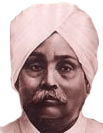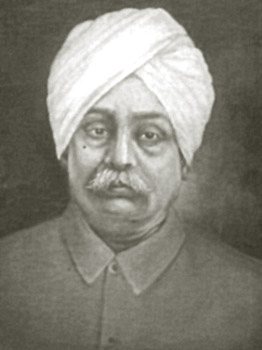skip to main |
skip to sidebar
Lala Lajpat Rai
 Lala Lajpat Rai, popularly known as "Punjab Kesari", was born on January 28, 1865 in Jagraon tehsil of the Ludhiana district, Punjab, in a Hindu Aggarwal family. His mother, Gulab Devi, came from a Sikh family. Lajpat Rai's family was far from affluent.
Lala Lajpat Rai, popularly known as "Punjab Kesari", was born on January 28, 1865 in Jagraon tehsil of the Ludhiana district, Punjab, in a Hindu Aggarwal family. His mother, Gulab Devi, came from a Sikh family. Lajpat Rai's family was far from affluent.
Lajpat Rai's interest in politics was aroused by his father who in his early life was a great admirer of Sir Syed Ahmed Khan but whom he condemned later for his anti-Congress tirade.
Lajpat Rai too had shared his father's admiration for Sir Syed Ahmed Khan but from 1888 began to criticize in his writings the anti-Congress activities of Sir Syed. Lajpat Rai's father was well-versed in Urdu and Persian, had great respect for Islam, fasted and prayed like a Muslim, but did not embrace Islam largely due to his wife's attachment to the Hindu and Sikh faiths. The Arya Samaj movement, a vital force in the Punjab in the later 19th and early 20th century, had a tremendous appeal for Lajpat Rai (he had met Swami Dayanand at fourteen), who came under its influence from his student days. It was his attachment to the Arya Samaj which led his father also to veer round to Hinduism.
Lajpat Rai's political activity began from 1885 when he joined the Congress session at Allahabad. In the early part of his political career, his interest was confined to social and educational reforms, but his views on politics changed radically as a result of the hasty and ill-conceived measures thrust on the country by Lord Curzon. He organised big meetings in the Punjab, travelled widely, raised funds for the national cause and exposed the poverty of the people and its causes. He brought out in his writings and speeches lurid comparisons between the economic conditions in India and those in the Western countries, and attacked the economic exploitation by the British as oppressive.
As the need for partition and independence took an important turn for the possible, Lajpat Rai’s involvement became imperative to the Indian Independence Movement. His actions in anti-imperialist movements led to numerous arrests. He became an important member of the Arya Samaj. This political group was full of British-educated Indians who believed that Hinduism had a specific and direct impact on what it meant to be Indian. The group also took the ideas of a merged western and eastern world and promoted the view that the subcontinent had benefited from its coagulation. The involvement of the Arya Samaj in constitutional reform supported the freedom movement which took hold of the Indian population. Lajpat Rai led political rallies which taught how the history of the subcontinent had always been heading to the philosophical idea that it would become an independent nation.[3]
Lajpat Rai presided over the first session of the All India Trade Union Congress in 1920. In 1923, he became a member of the Imperial Legislative Assembly. He also went to Geneva to attend the eighth International Labour Conference in 1926 as a representative of Indian labour. He had an opportunity to watch the labour movement in the USA and England where he was required to prolong his stay for political reasons.
In addition to espousing his philosophical principles, Lajpat Rai engaged heavily in direct action and protest against British rule. He led the Punjab protests against the Amritsar Massacre (1919), the Non-Cooperation Movement (1919 - 1922), and the “Simon go back” demonstrations against the Simon Commission (1928). He was repeatedly arrested.He disagreed, however, with Mohandas Gandhi’s suspension of the movement due to the Chauri Chaura incident, and formed the Congress Independence Party, which was particularly pro-Hindu in voice and policy.
He was not only a good orator but also a prolific and versatile writer. His journal Arya Gazette concentrated mainly on subjects related to the Arya Samaj. Bande Mataram and People, contained his inspiring speeches to end oppression by the foreign rulers. He founded the Servants of the People Society, which worked for the freedom movement as well as for social reform in the country. He also wrote an autobiography in English titled The Story of My Life. 
Lajpat Rai’s journey to the United States during World War I helped him to gather knowledge of how an independent nation formulates a nationalist identity. This is where he gathered information about how foreign nations, specifically Britain’s imperialist hold on India, had negative affects on the people, the lifestyles, and the ability to generate bonds with other nations. He wrote articles that persuaded foreign nations to side with the subcontinent’s struggle for independence. By accepting that westernized ideals were positive to the creation of nationalities, he gained support for breaking from Britain.[3] In Europeanization and the Ancient Culture of India, Lajpat Rai wrote that nationalization of India was imperative to spread western ideology to the rest of the world. Since the westernization of India had successfully been adapted while continuing traditions remained a large part of the culture, he believed that India no longer needed an overbearing imperialist government. He wrote that: “at first sight it seems absurd to give one name to all Indian civilization. But a close examination for facts and data amply proves the unity of Indian civilization, at least for the present geological period.” [4] These ideas were passed to foreign countries in order to show that despite cultural differences from the western world, India’s society had become a sustainable, functional nation which deserved its own nationality as opposed to being overseen by an alien western country.
Writings by Lajpat Rai include Josiah Wedgewood - The Man And His Work, The United States of America: A Hindu’s impressions and a study, History of the Arya Samaj, Swaraj and social change, England’s Debt to India: A historical narrative of Britain’s fiscal policy in India, The Problems Of National Education In India and Unhappy India: Being a reply to Katherine Mayo’s “Mother India”, published in 1928. (Mother India was a polemical account of India’s self rule by American historian Katherine Mayo.) Arya Smaj Life:
Lajpat Rai came early under the influence of the dynamic Hindu reformer, Dayanand Saraswati, the founder of the Arya Samaj. In conjunction with like minded people like Mahatma Hans Raj and Lala Sain Das, he was instrumental in laying the foundations of a strong Arya Samaj presence among the Punjabi Hindu urban populace. This was accomplished through the establishment of a network of schools and colleges (the Dayanand Anglo-Vedic (DAV) educational institutions) which met the aspirations of urban Hindu mercantile classes (Khatris, Aroras and Banias etc.) for an anglicized education leavened with traditional Hindu learning. These parochial institutions also served to spread the refomist message of the Arya Samaj during the late 19th century, a period when there was a fierce contest in the neighboring North Western Provinces (NWP, later renamed UP (United Provinces of Agra and Awadh, now called Uttar Pradesh) between the newly resurgent Hindi and Urdu for supremacy as the second official language after English. This debate spilled over to the Punjab, and Rai and the Arya Samaj were major players in it. Prior to the advent of the Arya Samaj on the Punjab scene, the urban Hindu Khatri and Arora communities enjoyed very cordial relationships with the Sikh communities. Dayanand Saraswati's intemperate attacks on the Sikh Gurus, and Rai's campaign for Hindi have caused schisms between the communities which still persist.






No comments:
Post a Comment